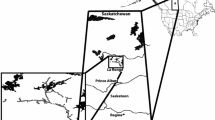Summary
We investigated differences in annual breeding population stability and its relationship to diversity in food habits for several species of raptors. Chi-square tests showed no significant differences between observed and expected (based on logistic growth equation) breeding population sizes for Peregrine Falcons (Falco peregrinus) during recovery from pesticide induced declines in 4 Alaskan populations. This indicates that no major Peregrine Falcon population fluctuations occurred aside from the recovery itself. On the Colville River, Alaska, Rough-legged Hawk (Buteo lagopus) and Gyrfalcon (F. rusticolus) breeding populations experienced several declines and increases during the Peregrine Falcon recovery. Serial correlation analysis does not indicate consistent regularity in fluctuation for either the Rough-legged Hawk or Gyrfalcon on the Colville River during 1967–1985. Possible occurrence of regular fluctuations in sub-populations or over shorter time periods, however, could not be investigated. Population fluctuations for the Rough-legged Hawk and Gyrfalcon are significantly correlated during 1971–1985, with largest declines for both occurring synchronously. This correlation is consistent with the possibility that shared environmental stresses, among other factors, are responsible for population limitation. Regularity, with a 3 year interval, is indicated, however, for extremely small fluctuations in an Idaho, USA population of the Red-tailed Hawk (Buteo jamaicensis), suggesting that investigations of raptor population fluctuation and regelarity should not be limited to arctic or subarctic environments. Low diversity in food habits is not a good predictor of degree of annual population fluctuation in the study groups, while greater diversity in food habits is associated with relatively stable annual populations. An association was found in the Rought-legged Hawk between reduced annual population variability and reduced climatic severity. Neither food habits diversity nor annual population variability is constant across species ranges. Food habits diversity was also variable between years in local populations of Peregrine Falcon, Rough-legged Hawk and Gyrfalcon.
Similar content being viewed by others
References
Bengtson S-A (1971) Hunting methods and choice of prey of Gyrfalcons (Falco rusticolus). Ibis 113:468–476
Cade TJ, Lincer JL, White CM, Roseneau DG, Swartz LG (1971) DDE residues and eggshell changes in Alaskan falcons and hawks. Science 172:955–957
Hagen Y (1969) Norwegian studies on the reproduction of birds of prey and owls in relation to micro-rodent population fluctuations. Fauna 22:73–126
Hickey JJ, Anderson DW (1969) The Peregrine Falcon: life history and population literature. In: Hickey JJ (ed) Peregrine Falcon populations. The Univ. of Wisconsin Press. Madison, pp 3–42
Levins R (1968) Evolution in changing environments. Princeton Univ. Press, Princeton, New Jersey
Lincer JL, Cade TJ, Devine JM (1970) Organochlorine residues in Alaskan Peregrine Falcons, Rough-legged Hawks and their prey. Canadian Field Nat 84:255–263
Mindell DP (1983) Nesting raptors in southwestern Alaska, status, distribution and aspects of biology. Techn. Publ. No. 8. Bureau of Land Management, Alaska State Office, Anchorage
Moran PAP (1953) The statistical analysis of the Canadian lynx cycle. I. Structure and prediction. Austr J Zool 1:163–173
Newton I (1980) The role of food in limiting bird numbers. Ardea 68:11–30
Palmgren P (1949) Some remarks on the short-term fluctuations in the numbers of northern birds and mammals. Oikos 1:114–121
Pasanen S, Sulkava S (1971) On the nutritional biology of the Rough-legged Buzzard, Buteo lagopus lagopus Brünn., in Finnish Lapland. Aquila Ser Zool 12:53–63
Pielou EC (1974) Population and community ecology. Gordon and Breach Science Publishers, New York
Platt J (1977) The breeding behavior of wild and captive Gyrfalcons in relation to their environment and human disturbance. Ph.D. thesis, Cornell University, Ithica, New York
Ratcliffe D (1980) The Peregrine Falcon. Buteo Books, Vermillion, S. Dakota
Roseneau D (1972) Summer distribution, numbers and food habits of Gyrfalcons (Falco rusticolus L.) on the Seward Peninsula, Alaska. M.Sc. thesis, Univ of Alaska, Fairbanks
Sokal RR, Rohlf FJ (1981) Biometry. W.H. Freeman and Co., San Francisco
Springer A (1975) Observations on the summer diet of Rough-legged Hawks from Alaska. Condor 77:338–339
Swartz LG, Walker W, Roseneau DG, Springer AM (1974) Populations of Gyrfalcons on the Seward Peninsula, Alaska, 1968–1972. Raptor Res. Foundation Raptor Res. Report 3:71–75
Thiollay JM (1982) Les resources alimentaires, factor limitant la reproduction d'une population insulaire de Faucons Pelegrins, Falco peregrinus brookei. Alauda 50:16–44
White CM, Cade TJ (1971) Cliff-nesting raptors and ravens along the Colville River in arctic Alaska The Living Bird 10:107–150
White CM, Emison WBE, Williamson FSL (1973) DDE in a resident Aleutian Island Peregrine population. Condor 75:306–311
White CM, Cade TJ (1977) Long term trends of Peregrine populations in Alaska. In: Chancellor RD (ed) World Conf. on Birds of Prey. Internat. Counc Bird Preservation, Vienna, Austria, pp 63–72
White CM (1983) The beginning of an endangered species comeback: the Peregrine Falcon. Amer Biol Teacher 46:212–220
Wiens JA (1984) Resource sytems, populations, and communities. In: Price PW, Slobodchikoff CN, Gaud WS (eds) A new ecology. John Wiley and Sons, New York pp 397–436
Author information
Authors and Affiliations
Rights and permissions
About this article
Cite this article
Mindell, D.P., Albuquerque, J.L.B. & White, C.M. Breeding population fluctuations in some raptors. Oecologia 72, 382–388 (1987). https://doi.org/10.1007/BF00377568
Received:
Issue Date:
DOI: https://doi.org/10.1007/BF00377568



